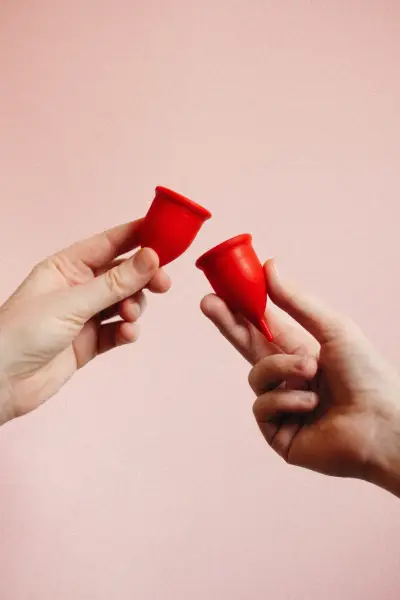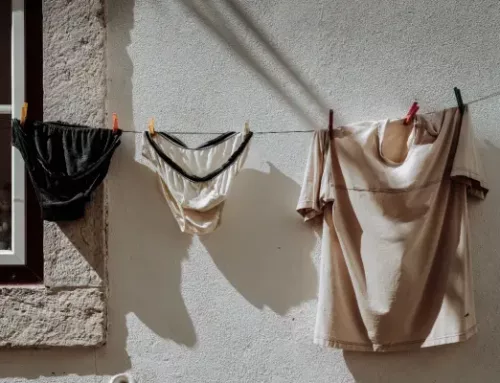Most of you have probably heard of the menstrual cup but may be new to the menstrual disc. So let’s start with a short description and comparison.
What is a menstrual cup?
Menstrual cups are bell-shaped devices that are inserted into the vagina and sit against the cervix to collect menstrual fluid. They are made of silicone, rubber, or latex. You can get them in different sizes and shapes to fit a variety of body types. They need to be removed, emptied, and cleaned every 8 -12 hours.
What is a menstrual disc?
Menstrual discs, on the other hand, are small, flexible, disc-shaped devices that are inserted into the vaginal fornix, which is located beyond the cervix. They are made of silicone or similar materials and need to be removed and emptied every 12 hours.

Menstrual disc vs cup
While there are some differences between menstrual cups and menstrual discs, they share several important similarities.
Similarities between discs and cups:
- Reusability: Both menstrual cups and menstrual discs are reusable menstrual products that can be used for several years with proper care (note that discs are offered as both reusable and disposable)
- Environmentally friendly: Since they are reusable, both menstrual cups and menstrual discs produce less waste than disposable menstrual products.
- Collect menstrual fluid: Both products collect menstrual fluid rather than absorbing it. This can help reduce the risk of toxic shock syndrome.
- Can be worn during activities: Menstrual cups and menstrual discs are both suitable for any physical activity.
- Comfortable: Both menstrual cups and menstrual discs can be comfortable to wear when inserted correctly. They can be great alternatives for those who experience discomfort with traditional menstrual products like tampons or pads.
- Safe to use: Both products are considered safe to use, although it is important to follow the instructions for use and care provided by the manufacturer.
That was some of the things they have in common. Another thing they share is the price. They cost about the same, $30. You can find cheaper cup options, but not all of them are equally good when it comes to fit.
We all look different and some might recommend other products but I especially like the Saalt cup as it is very soft and comfortable. I have tried cheaper brands and think the investment is worth it. It will last you years to come.
Let’s move on to what separates the disc and cup to make it easier for you to make a decision.
Differences between discs and cups:
- Design & Placement: Menstrual cups are bell-shaped and sit in the vaginal canal, while menstrual discs are disc-shaped and sit at the base of the cervix.
- Capacity: Menstrual discs generally have a higher capacity than menstrual cups and can hold up to 70 ml of fluid, while menstrual cups have a capacity of around 30-40 ml.
- Sex: You can wear a menstrual disc during sexual intercourse. Unlike menstrual cups, menstrual discs are specifically designed to be worn during sexual activity.
- Removal: To remove a menstrual cup, you need to pinch the base of the cup and gently pull it out. To remove a menstrual disc, you need to hook your finger under the rim and pull it out.
- Cleaning: Both menstrual cups and menstrual discs need to be cleaned regularly, but the cleaning process is slightly different. Menstrual cups can be emptied and rinsed with water or washed with a mild soap, while menstrual discs need to be emptied and wiped clean with a damp cloth or rinse in water.
- Fit: Menstrual cups come in different sizes and shapes to fit a variety of body types, while menstrual discs are available in one size that may not work for everyone.
- Reusable & Disposable: Since you can buy disposable discs but not cups the disc can offer something the cup can’t.
Pros and cons of menstrual cups
Overall, menstrual cups can be a great option for those looking for an eco-friendly, cost-effective, and comfortable menstrual product. However, they may not be suitable for everyone and require some patience and practice to get used to.
Pros of menstrual cups:
- Eco-friendly: Menstrual cups are reusable, which means they produce less waste compared to disposable menstrual products.
- Cost-effective: While the initial cost of a menstrual cup may be higher than disposable products, they can last for several years, making them a cost-effective option in the long run.
- Longer wear time: Menstrual cups can be worn for up to 12 hours, which is longer than tampons or pads.
- Comfortable: Many users find menstrual cups to be more comfortable than traditional menstrual products like tampons or pads.
- No odor: Unlike pads, menstrual cups do not produce an odor since they collect menstrual fluid rather than absorbing it.
Cons of menstrual cups:
- Learning curve: There may be a learning curve when first using a menstrual cup, as it requires proper insertion and removal techniques.
- Messy: Removing and cleaning the menstrual cup can be messy, especially in public restrooms.
- Not one-size-fits-all: Finding the right size and fit can be a challenge, as not all menstrual cups work for every body type.
- Can cause discomfort: Some users may experience discomfort or irritation when using a menstrual cup.
- Requires cleaning: Menstrual cups require proper cleaning and sanitizing after each use, which can feel time-consuming.
Pros and cons of menstrual discs
Overall, menstrual discs can be a good option for those looking for mess-free, long-wear period protection that can be used during sex. However, they may not be suitable for everyone and require some practice to get used to.
Pros of menstrual discs:
- Longer wear time: Menstrual discs can be worn for up to 12 hours, which is longer than tampons or pads.
- Mess-free: Menstrual discs collect menstrual fluid in a way that prevents leaks and avoids the messiness associated with traditional products like pads and tampons. That is if you’re choosing disposable discs. I guess the reusable ones aren’t exactly labelled mess-free.
- No odor: Similar to menstrual cups, menstrual discs do not produce an odor since they collect menstrual fluid rather than absorbing it.
- Easy to use: Once inserted, menstrual discs require minimal adjustments and can be easily removed with a simple hooking motion.
- Can be worn during sex: Unlike other menstrual products, menstrual discs can be worn during sex, providing mess-free period protection without disrupting intimacy.
Cons of menstrual discs:
- Learning curve: There may be a learning curve when first using a menstrual disc, as it requires proper insertion and removal techniques.
- Not one-size-fits-all: Finding the right size and fit can be a challenge, as not all menstrual discs work for every body type. Most offer just one size.
- Limited capacity: Menstrual discs have a lower capacity than menstrual cups, which means they may need to be emptied more frequently.
- Cost: Menstrual discs can be more expensive than other menstrual products, especially if they need to be replaced frequently (if you don’t go for the reusable ones).
- Requires cleaning: Menstrual discs require proper cleaning and sanitizing after each use, which can be time-consuming (again, if you go for the reusable ones).
Should I choose menstrual disc or cup?
The decision to choose between a menstrual disc and a menstrual cup ultimately depends on your individual preferences, body type, and lifestyle. Here are some factors to consider when making your decision:
- Menstrual discs can be a better option for those who have a low cervix.
- Try menstrual discs of you experienced discomfort or leakage with menstrual cups.
- Menstrual discs may be preferred by those who have a heavier flow.
- Try cups if you prefer a more traditional menstrual product design (you may also find super cheap ones that you like)
- Menstrual discs can be more expensive than menstrual cups.
- If you’re physically active, you may prefer a menstrual cup or disc that provides secure and long-lasting protection without the need for frequent changes.
Ultimately, the choice between menstrual cups and menstrual discs comes down to personal preference and individual anatomy. It may of course be helpful to try both products to see which one works best for you.






Leave A Comment